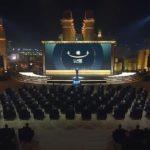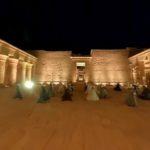(MENAFN- Brazil-Arab News Agency (ANBA)) >
Cairo – In a magnificent event, the Egyptian president, Abdul-Fattah Al-Sisi, presented the new Luxor Museum to the world, with its antiquities and treasures from a civilization dating back over 5,000 years. The boulevard known as“Avenue of Sphinxes” (also known as“Rams Road” or“Path of the Gods”) was rescued and revived in the presence of many international personalities, ambassadors from over 35 countries, and more than 200 local and foreign media representatives. The museum's reopening occurred last week, drawing the world's attention.
The event aimed to promote tourism in the city of Luxor, positioned the museum as the world's largest outdoor museum, highlighting the unique and differentiated features and tourist and archeological tours of the city, such as the sunny weather, cruises on the Nile River, balloon rides, the glamorous carriage ride on the corniche on the banks of the Nile, in addition to the local market, where visitors can find shops selling spices and traditional products of the region.
In addition to the revitalization of boulevards such as the Avenue of Sphinxes, important projects were completed, such as the new visual identity of the city and the development of the corniche on the banks of the Nile. The Avenue of Sphinxes is a walkway with statues that mix the bodies and heads of humans, lions, and sheep.
The Opet Festival
Celebrations in Ancient Egypt were divided into several events: the official festivals celebrated throughout the country, such as New Year, the first day of the month, mid-month festivals, and the king's coronation, in addition to local festivals celebrated in a single region. There were also religious festivals, such as one in praise of the god Min, held in the first month of harvest time, and the Opet Festival.
Many important religious holidays were celebrated in Luxor and the ancient capital of Egypt, Thebes. The Opet Festival was one of the most important celebrations of the year, as it was named after the second month of the season of Akhet, the season of floods. On this occasion, the statues of the Trinity of Thebes were taken from their sanctuary at Karnak to the Temple at Luxor to meet with Amenemope.
A long road lined with statues of sphinxes connects the two temples, and the magnificent procession of the annual Opet Festival used to travel back and forth from Karnak to the Temple of Luxor. An alternative route was also used across the Nile River, with a fleet of boats making up a large procession. During Hatshepsut's reign, the overland route was used to go to the Temple of Luxor, while the one across the river was used on the way back. However, at the end of the 18th dynasty, the river route was used for both the outward and the return journeys.
The pharaohs of the modern state were very careful in reenacting the various scenes of the Opet Festival, the most notable being: Hatshepsut, on the walls of the Red Chapel of Karnak; Thutmose III, on the walls of the Temple of Akhmenu; Amenhotep III, in the Third Building; Horemheb, in the courtyard between the Ninth and the Tenth Building; Seti I, in the Great Court of Sages, in Karnak; and Ramesses III, at Karnak and the city of Habu.
On the walls of the Great Hall of the Temple of Luxor, this procession was depicted in great detail, in which some soldiers marched, bearing their weapons, to the sound of music, others with horns and drums. At the same time, dancers further animated the festivities. Before them, fattened oxen were offered as sacrifices, while nobles paraded in their chariots to the sound of chanting sung by priests and priestesses.
The Opet Festival used to last several days, but this varied between dynasties. In the reign of Thutmose III, it was 11 days. However, during the reign of Ramesses III, the celebration spanned 24 days. There are indications the Egyptians continued to celebrate the Opet Festival until the Roman Empire.
The purpose of the Opet Festival was to transfer the statues of Amon, Mut, and Quensu to the Temple of Luxor, where they would join that of Amenemope, to renew their youth, the youth of the king, and all nature, mainly when floods occurred, before of returning north to Karnak. Due to this peculiarity, which makes Egypt a country unlike any other in the world, such religious celebrations in Luxor have continued to the present day, but with a different purpose for Christians and Muslims.
Renovation of the Marina
Before the opening, the Egyptian Ministry of Tourism and Antiquities completed the renovation and upgrading of the marina for floating hotels in Luxor. The Armed Forces Engineering Authority started implementing the Luxor Marina development project in November 2019, completed on October 1, 2021. The marina is divided into two parts: the first is 450 meters long and can accommodate five berths for floating hotels; the second section is 730 meters long and can accommodate up to six. The marina also has 69 shops.
The project included a drainage network for Nile boats along the marina, as well as fire protection. The area was paved with marble, granite, and black basalt floors, where planters were installed, in addition to 17 wooden pergolas and six tourist service kiosks decorated with engravings incorporating the differentiated visual identity of Luxor.
The marina was decorated with the installation of artistic murals based on the integration of Arabic calligraphy and images of men and women from Ancient Egypt and Upper Egypt, with the reproduction of stunning landscapes and icons, such as palm trees and sailboats. Polyester murals were also built, mainly depicting scenes from the daily life of ancient Egyptians, during the pharaonic civilization, with night lighting.
Check out below some of the pictures of the opening released by the Egyptian government:


 Avenue of Sphinxes
Avenue of Sphinxes
The construction of the boulevard known as the“Avenue of Sphinxes” began at the hands of King Amenhotep III, who started the building of the Temple of Luxor, but most of the work is owed to King Nectanebo I.
The boulevard is 2,750 meters long and 700 meters wide, along which are lined up, on both sides, about 1,200 statues, each carved from a single block of sandstone, presenting two types of shapes: a lion's body and a human head (the lion is one of the symbols of the Sun god), or a human body with a ram's head, symbolizing Khnum, the god of fertility according to ancient mythology, revered as the creator of all humankind.
The Great Road of Processions, or“Avenue of Sphinxes,” was a vital procession route for kings and pharaohs in ancient times. Several seasonal festivities were celebrated there, including the Opet Festival and the King's Coronation, in addition to other national celebrations. In the past, there was a massive stone dam to protect the road on the west side of the city of Luxor, which was the political capital of the modern state and the religious capital until the Roman Empire.
The restoration
The restoration project started in 2005, was interrupted in 2011 and resumed in September 2017. During road excavations, a large number of statues were discovered, divided into two forms: a lion's body with a human's head and a human's body with a ram's head, as well as a series of residential, administrative, and service buildings, which dated back to the Greco-Roman era, kilns for making pottery and amulets, a mudbrick building from the 21st Dynasty of King Menkheperre, and a 10th century AD tomb.
The boulevard was renovated and turned into an open-air museum, with an exhibition of rare paintings from the 19th century, which narrate the history of the temples of Karnak and Luxor, the procession route, which connects the temples, and the most important archaeological discoveries, illustrations, and scenes of festivals and celebrations that were held in ancient times, as well as images of the kings who contributed to the road's construction. A road lighting system was also developed to highlight its beauty.
Karnak Temple
The Great Hypostyle Hall in the Temple of Karnak was cleaned and restored, and of its 134 pillars, 12 were renovated. Over 130 Egyptian restorers participated. The restoration, assembly, and reinstallation of the statue of King Thutmose II in the Temple of Karnak was carried out; the statue had been divided into 74 pieces since its discovery. After its restoration, the statue stands about 11 meters tall, one of the largest in the Karnak Temple complex; the process took about six months.
The restoration of the statue of the god Amon from the era of King Tutankhamun was also completed in cooperation with the Egyptian-French Center for Studies at the Temple of Karnak, where the complete restoration design of the statue was made and chest and left leg areas completed, based on another statue similar in appearance and history, which is in the Egyptian Museum in Tahrir.
Luxor temple
The Egyptian Ministry of Tourism and Antiquities developed a lighting system for the Temple of Luxor and promoted the restoration of the heads of five statues of King Ramesses II, returning them to their original places in the statues' bodies in the courtyard of King. In addition, the cleaning, restoration, and reinstallation of two statues of King Ramesses II at the temple's west gate were carried out.
The restoration of the 14-column hall, built by Kings Tutankhamun and Horemheb, has also been completed. The pillars of the great ceremonial hall, the facade of the temple, and its statues were cleaned and restored, and gates were also installed to access the“Avenue of Sphinxes.”
Translated by Georgette Merkhan & Elúsio Brasileiro
The post Meet the world's largest open-air museum in Egypt appeared first on Agência de Notícias Brasil-Árabe .
MENAFN30112021000213011057ID1103283168